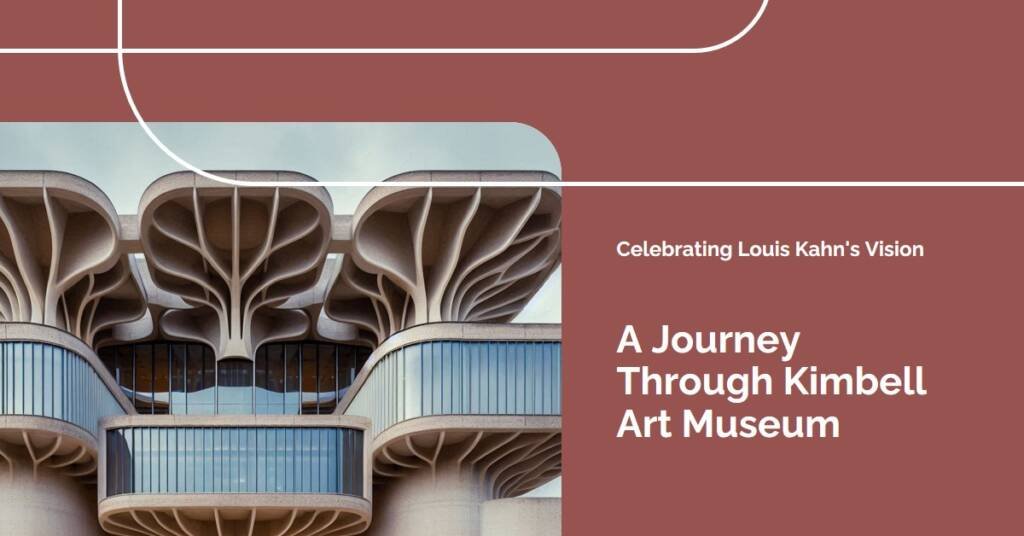
Table of Contents
- Introduction to the Kimbell Art Museum
- Louis Kahn: A Visionary Architect
- Architectural Features of the Kimbell Art Museum
- The Artwork Collection: A Treasure Trove
- Visitor Experience: Engaging with Art in Kahn’s Space
- Kahn’s Legacy in Contemporary Architecture
- The Kimbell’s Role in the Local Community
- Challenges and Controversies in the Museum’s History
- Conclusion
Introduction to the Kimbell Art Museum
The Kimbell Art Museum, located in Fort Worth, Texas, is widely regarded as one of the most important art museums in the United States. Established in 1972 through a generous endowment by Kay and Velma Kimbell, the institution was designed by the renowned architect Louis Kahn, whose vision transformed the conventional approach to museum architecture. The museum’s collection encompasses a diverse array of artworks, ranging from ancient to contemporary pieces, including European masterpieces, American art, and significant works from Asia and Africa. This diverse assemblage not only highlights the breadth of human creativity but also fosters an appreciation for art across different cultures and periods.
Architecturally, the Kimbell Art Museum is characterized by its elegantly simple design, which blends forms and materials with a lyrical quality seldom seen in modern architecture. Kahn’s innovative use of natural light plays a crucial role in the visitor experience, as daylight filters through the unique skylights and illuminates the artworks in an enchanting manner. This thoughtful design approach encapsulates Kahn’s belief in the harmony between space and light, creating an environment where art can be experienced vividly. The museum’s robust concrete structure, complemented by smooth travertine walls, further exemplifies Kahn’s commitment to durability while fostering intimacy and connection between the viewer and the exhibited works.
In essence, the Kimbell Art Museum is not only a repository of artistic treasures but also a masterpiece of architectural design, showcasing Louis Kahn’s visionary perspective. His thoughtful integration of light and space reflects a profound understanding of the museum’s role in enriching cultural dialogue and fostering an enduring appreciation for art. The museum serves as a vital institution within the art world, drawing visitors and scholars alike, and establishing itself as a pivotal space for the exploration of artistic expression.
Louis Kahn: A Visionary Architect
Louis Kahn, a prominent figure in modern architecture, is renowned for his innovative approach that transcended traditional design principles. Born in 1901 in Estonia, Kahn immigrated to the United States with his family as a child. His education in architecture at the University of Pennsylvania set the stage for a career characterized by a profound understanding of light, space, and materials. Kahn’s architectural philosophy is often defined by an emphasis on the emotional experience of the built environment, where he designed structures that encouraged contemplation and interaction with their surroundings.
Throughout his career, Kahn developed a unique aesthetic that harmonized spatial form with functionality. He famously articulated the concept of “served” and “servant” spaces, which informed the organization of his buildings. This methodology is especially evident in the Kimbell Art Museum, where each gallery functions as a “served” space, housing art and experiences, while the supporting services are cleverly integrated and less obtrusive. Kahn’s mastery over light is particularly notable, with the deliberate use of natural light through skylights that gracefully illuminates the artworks, allowing the viewer to experience them in a dynamic interplay of shadow and brightness.
Kahn’s use of materials also reflects his architectural vision. The Kimbell Art Museum is constructed primarily from concrete and brick, chosen not only for their durability but also for their inherent textural qualities that contribute to the overall aesthetic. He believed that the essence of materials should resonate with the purpose they serve. Thus, the concrete structure offers a raw yet refined quality, fostering a sense of permanence and serenity. The interplay of light and material in the museum embodies Kahn’s artistic philosophy, showcasing his belief that architecture should elevate the human experience while framing the art within a contemplative environment.
Architectural Features of the Kimbell Art Museum
The Kimbell Art Museum, designed by the renowned architect Louis Kahn, is celebrated for its distinctive architectural elements that seamlessly blend artistry with function. One of the most iconic features of the museum is its vaulted ceilings, which are constructed from concrete and provide both structural integrity and aesthetic appeal. These ceilings create an expansive feeling within the gallery spaces while allowing for unique variations in height, enhancing the visitor’s experience as they move through the museum.
Natural light plays a pivotal role in the design of the Kimbell Art Museum. Kahn ingeniously incorporated skylights that filter sunlight into the galleries, providing a soft, diffused light that enhances the viewing of the artwork. This emphasis on natural light not only illuminates the art in a manner that accentuates its colors and textures but also creates a dynamic atmosphere that changes throughout the day. The relationship between light and space is a fundamental aspect of the museum’s architectural philosophy, emphasizing the importance of viewing art in a way that engages the senses.
Moreover, the interplay between indoor and outdoor spaces at the Kimbell is meticulously crafted. The museum is situated in a beautifully landscaped setting, promoting a harmonious connection with its environment. Visitors are encouraged to transition between the interiors and the outdoor gardens, offering a sense of tranquility and reflection. The natural surroundings serve as an extension of the museum, allowing patrons to experience art not only in a traditional gallery setting but also amidst nature’s serenity. This integration of the building with its landscape is intrinsic to Kahn’s vision, ultimately enhancing the overall visitor experience at the Kimbell Art Museum.
The Artwork Collection: A Treasure Trove
The Kimbell Art Museum boasts an impressive permanent collection, showcasing a diverse array of artworks that span from the European Renaissance to modern art. The museum’s collection is particularly noteworthy for its careful curation of pieces that not only represent various artistic movements but also highlight the evolution of artistic expressions over centuries. Among the prominent artists featured in the collection are renowned figures such as Michelangelo, Rembrandt, and Monet, each contributing their unique style and vision to the broader narrative of art history.
One of the most celebrated works in the collection is Michelangelo’s “The Torlonia Venus,” a stunning marble sculpture that exemplifies the mastery of the Renaissance era. This piece, alongside Rembrandt’s “Self-Portrait,” reveals the profound emotional depth and technical skill characteristic of the period. Meanwhile, transitioning into modern art, works by artists like Diego Rivera and Picasso further illustrate the global influence on artistic movements and the importance of cultural exchange in shaping the visual arts.
The museum’s architectural design, conceived by Louis Kahn, plays a pivotal role in enhancing the appreciation of these works. The interplay of natural light and space creates an intimate atmosphere that allows visitors to engage with the art on a deeper level. Kahn’s approach to using light not only illuminates the artwork but also accentuates its colors and textures, resulting in a dynamic viewing experience. In addition, the thoughtful arrangement of the galleries encourages visitors to explore the connections between different pieces, fostering a dialogue among the artworks that enriches the overall experience.
In this treasure trove of artistic excellence, the Kimbell Art Museum stands as a beacon of cultural enrichment, inviting audiences to reflect on the vast diversity and history of art. With its unique collection and the visionary design by Kahn, the museum continues to celebrate the significance of these masterpieces, ensuring that they remain accessible for generations to come.
Visitor Experience: Engaging with Art in Kahn’s Space
Visiting the Kimbell Art Museum is not merely about observing art; it is an immersive experience that invites guests to engage deeply with both the art and the architectural vision of Louis Kahn. The design of the museum itself plays a pivotal role in enhancing the visitor experience. Kahn’s innovative use of natural light and space creates an atmosphere that encourages contemplation and reflection, making it a profound setting for art appreciation. This interplay between art and architecture fosters a unique environment that draws in visitors, enriching their understanding of both the works on display and the space housing them.
The museum offers guided tours led by knowledgeable docents who provide insights into the art collection and Kahn’s architectural ethos. These tours serve as an educational tool, helping visitors navigate the museum’s collections while deepening their appreciation of the artistic and architectural elements. Additionally, special educational programs are frequently organized, including lectures, workshops, and family-friendly activities designed to engage diverse audiences. Educational initiatives aim to enhance the understanding of art history and architectural principles, enabling participants to explore Kahn’s concepts in a hands-on manner.
Interactive installations also play a significant role in the visitor experience, further encouraging engagement with both the art and the space. These installations often involve technology or participatory components that invite active involvement from museum-goers. The combination of Kahn’s thoughtfully designed spaces with modern enhancements creates a dynamic experience that resonates with various demographics, fostering interaction and personal connections with the art.
In conclusion, the Kimbell Art Museum stands as a testament to how architecture can elevate the experience of viewing art. Through guided tours, educational programs, and interactive installations, visitors are invited to engage with the museum’s offerings in a meaningful way, all while being enveloped by the brilliance of Kahn’s architectural vision.
Kahn’s Legacy in Contemporary Architecture
Louis Kahn’s architectural philosophy continues to resonate deeply within the fabric of contemporary architecture. The Kimbell Art Museum, one of his most celebrated works, exemplifies principles that have inspired a plethora of modern architects. Kahn advocated for buildings that exemplified a sense of permanence, an ethos that resonates within the walls of the Kimbell, characterized by its use of natural light, thoughtful materiality, and geometric clarity. These underlying principles have influenced modern design, encouraging architects to prioritize spatial experience and contextual integrity.
One significant example of Kahn’s influence can be observed in the work of architect Tadao Ando. His use of concrete and interaction with light mirrors Kahn’s meticulous attention to how materials and daylight interact within a space, as seen in the Church of the Light in Osaka. Ando’s designs embody a simplicity that resonates with Kahn’s vision, creating profound spaces that foster reflection and connection. Similarly, Robert Venturi’s Vanna Venturi House exhibits Kahn’s principles of complexity within simplicity while challenging traditional notions of form and function.
Another prominent figure influenced by Kahn is Deborah Berke, whose designs emphasize the tactile quality of materials and the importance of light in shaping architectural experience. Her approach at the Yale School of Art showcases Kahn’s legacy, stressing the significance of the relationship between interior and exterior spaces, offering both a sense of openness and defined structure. These contemporary interpretations of Kahn’s ideals highlight the enduring relevance of his philosophies in addressing the needs of today’s architectural practices and the evolving urban context.
Ultimately, Louis Kahn’s architectural legacy thrives in the hands of modern architects who embrace his principles, adapting them to contemporary needs while capturing the timeless qualities that define great architecture. This rich dialogue ensures that Kahn’s vision remains a vital component of architectural discourse today.
The Kimbell’s Role in the Local Community
The Kimbell Art Museum serves as a vital cultural institution within the Fort Worth community, fostering an environment of creativity and collaboration. Since its inception, the museum has established itself not only as a venue for exceptional art but also as an essential contributor to the local arts scene. The Kimbell’s deliberate integration into the community is highlighted through various outreach initiatives and educational programs aimed at engaging diverse audiences.
One remarkable aspect of the Kimbell’s contribution to the community is its commitment to offering free public programs, which include workshops, lectures, and guided tours. These efforts encourage individuals of all ages to explore and appreciate art, promoting a broader understanding of cultural heritage. Additionally, the museum hosts seasonal events that celebrate regional artistry, allowing local artists to showcase their work while fostering connections among art enthusiasts and professionals.
In collaboration with schools, the Kimbell actively participates in educational outreach, providing resources and curriculum-based programs designed to enhance students’ engagement with art. Through tailored school visits and interactive lessons, students gain firsthand experience with the museum’s collections, thus nurturing a more extensive appreciation for artistic expression and cultural history. This partnership not only enriches the educational landscape of Fort Worth but also cultivates a future generation of art lovers and potential artists.
The Kimbell Art Museum also embraces its role as a cultural hub by engaging in partnerships with other local organizations, enhancing the collaborative spirit within the community. These partnerships further its mission of accessibility and inclusivity, ensuring that the museum is not merely a space for viewing art but a vibrant part of Fort Worth’s cultural fabric. In essence, the Kimbell stands as a beacon of artistic inspiration and community engagement, reflecting Louis Kahn’s vision while adapting to contemporary civic needs.
Challenges and Controversies in the Museum’s History
The Kimbell Art Museum, known for its architectural elegance and art collections, has faced a myriad of challenges and controversies since its establishment. One of the most pressing issues has been the ongoing funding challenges. Securing adequate financial resources for operations and special exhibitions has been critical to the museum’s success. Despite the initial vision and aspirations funded by the Kimbell family’s private endowment, the fluctuating economic climate has necessitated reliance on additional private donations and grants. This dependency on external funding sources frequently prompted discussions about the museum’s strategic direction and priorities.
Another significant area of contention revolved around expansion debates. As the Kimbell Art Museum has endeavored to grow its collection and serve an increasing number of visitors, the necessity for additional space became apparent. The decision to expand was not without its critics. Many ardent supporters of the original design by architect Louis Kahn expressed concerns that any new construction could potentially compromise the integrity of Kahn’s vision. Balancing the need for increased exhibition space while respecting Kahn’s original design principles posed a complex challenge, leading to extensive discussions about the architectural approach and the museum’s future.
Architectural criticisms have surfaced throughout the museum’s history, with some experts questioning the functionality and adaptability of Kahn’s design. While his work is revered for its aesthetic qualities, the museum has been scrutinized concerning its ability to facilitate modern exhibitions and visitor engagement. The integration of contemporary art displays within Kahn’s distinctive spatial framework has required innovative curatorial strategies, as museum staff seek to honor the building’s historical significance while making it relevant to today’s audiences.
Throughout these challenges, the Kimbell Art Museum continues to uphold its artistic integrity. The institution’s commitment to its mission of preserving and presenting significant works of art highlights the resilience and adaptability that have defined its history.


Conclusion
Louis Kahn’s vision for the Kimbell Art Museum stands as a monumental achievement in architectural history, blending functionality with a profound aesthetic experience. His innovative approach not only transformed the landscape of museum design but also established a lasting legacy that resonates within contemporary architectural practices. The carefully curated spaces within the Kimbell facilitate a unique interaction between artwork and viewer, emphasizing the significance of light and material—key elements that characterize Kahn’s oeuvre. This legacy transcends mere structural design; it embodies a philosophical perspective on the role of art and architecture in society.
In today’s rapidly evolving architectural and cultural contexts, Kahn’s work remains particularly relevant. The principles he championed—such as simplicity, serenity, and the profound connection between form and function—continue to inspire architects and designers worldwide. The Kimbell Art Museum serves as a testament to the importance of integrating art, architecture, and the environment, offering visitors a serene sanctuary that invites contemplation and engagement with art. This connection becomes more crucial as museums grapple with modern challenges of relevance and accessibility in a fast-paced world.
For art lovers and cultural enthusiasts, the Kimbell Art Museum is not merely a destination but an experience that honors Kahn’s visionary spirit. By celebrating his contributions, we not only recognize the past achievements of architectural brilliance but also ensure that future generations continue to appreciate and learn from his concepts. As we reflect on Kahn’s immense impact, it becomes clear that his vision for the Kimbell remains a pivotal point of reference in the dialogue surrounding art and architecture, securing its place as a must-visit destination for anyone seeking inspiration and insight into the synergy between these two disciplines.



